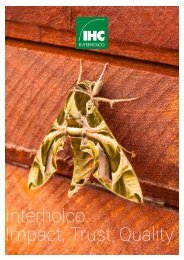Nomenclature Générale des Bois Tropicaux - 7ème édition
(english description below) Cette nomenclature est utilisée pour la mise à jour du 'Harmonized Code System' de l’Organisation Mondiale des Douanes. Dans la circulaire du 5 avril 2005, le Ministère de l’Economie, des Finances et de l’Industrie (France) reconnaît l’ATIBT comme « gardien du temple » de la nomenclature des bois tropicaux. La Commission Européenne mentionne la nomenclature de l’ATIBT comme document de référence pour la mise en œuvre du RBUE. Depuis 1954, l’ATIBT a établi et mis à jour une nomenclature des bois tropicaux faisant correspondre chaque espèce botanique avec un nom pilote reconnu internationalement. La détermination du nom pilote d’une essence est cruciale, car sa commercialisation dépend très largement de l’adoption de ce nom par le public. Le nom pilote assure la protection de l’appellation commerciale de l’essence et l’intégrité des propriétés qui lui sont attribuées, sans risque de confusion. The 1982 version of the general timber nomenclature has finally been updated as some of the 1,750 identified species, are no longer traded, while others, which were not previously included, are now on the market. The present revision has also integrated changes related to new taxonomy, in order to reflect the latest scientific developments. This Nomenclature has been used for the Harmonized Code System, updated by the World Customs Organization. The French Ministry of economy, finance and industry has given official recognition to ATIBT as the reference for the tropical timber nomenclature (NOR: PRMX0508285C of April 5th 2005). The European Commission refers to ATIBT nomenclature as a reference document for the implementation of the EUTR regulation. Since 1954, ATIBT has established and updated a nomenclature of tropical wood, linking each botanical species with an internationally recognized pilot name. A sigle wood species may have many common names; when trading across different countries, this may lead to confusion. Fixing the pilot name of a timber species is crucial, to protect the commercial denomination of the species and guarantee the veracity of the properties linked to that species, without confusion.
(english description below)
Cette nomenclature est utilisée pour la mise à jour du 'Harmonized Code System' de l’Organisation Mondiale des Douanes. Dans la circulaire du 5 avril 2005, le Ministère de l’Economie, des Finances et de l’Industrie (France) reconnaît l’ATIBT comme « gardien du temple » de la nomenclature des bois tropicaux. La Commission Européenne mentionne la nomenclature de l’ATIBT comme document de référence pour la mise en œuvre du RBUE.
Depuis 1954, l’ATIBT a établi et mis à jour une nomenclature des bois tropicaux faisant correspondre chaque espèce botanique avec un nom pilote reconnu internationalement. La détermination du nom pilote d’une essence est cruciale, car sa commercialisation dépend très largement de l’adoption de ce nom par le public. Le nom pilote assure la protection de l’appellation commerciale de l’essence et l’intégrité des propriétés qui lui sont attribuées, sans risque de confusion.
The 1982 version of the general timber nomenclature has finally been updated as some of the 1,750 identified species, are no longer traded, while others, which were not previously included, are now on the market. The present revision has also integrated changes related to new taxonomy, in order to reflect the latest scientific developments.
This Nomenclature has been used for the Harmonized Code System, updated by the World Customs Organization. The French Ministry of economy, finance and industry has given official recognition to ATIBT as the reference for the tropical timber nomenclature (NOR: PRMX0508285C of April 5th 2005). The European Commission refers to ATIBT nomenclature as a reference document for the implementation of the EUTR regulation.
Since 1954, ATIBT has established and updated a nomenclature of tropical wood, linking each botanical species with an internationally recognized pilot name. A sigle wood species may have many common names; when trading across different countries, this may lead to confusion. Fixing the pilot name of a timber species is crucial, to protect the commercial denomination of the species and guarantee the veracity of the properties linked to that species, without confusion.
You also want an ePaper? Increase the reach of your titles
YUMPU automatically turns print PDFs into web optimized ePapers that Google loves.
118 ///
Nomenclature générale des bois tropicaux 2016
NOMS VERNA-
CULAIRES
COMMON
NAMES
PAYS
COUNTRY
Lerado MX Capomo
Letoeng MY Jelutong
Letok MM Pulai
Letpan MM Kapok
NOM PILOTE
PILOT NAME
Letterhout SR Amourette
Lettoc-Thein MM Lanete
Lettre mouchete GF Amourette
Lian TH Xoan
Lian-Baiyai TH Xoan
Lianu CG Bubinga
Libas PH Benuang
Liboyo CD Sipo
Libu CG Oboto
Licari BR Bois de rose femelle
Lidia CM Framiré
Lieúque CL Manio
Lifaki CD Sapelli
Lifaki CD Tiama
Lifaki Muindu CD Dibétou
Lifondo CD Ilomba
Lifuco AO Kosipo
Light Hopea PG Merawan
Light Red Meranti MY Meranti, Light Red
Light Red Seraya MY Meranti, Light Red
Lignum vitae BO Palo santo
Ligudu CD Limbali
Lika Oedoe SR Inyak
Likundu CD Dabéma
Lilin ID Lilin
Lim VN Lim
Lim Xanh VN Siris
Limba CD Limba
Limba CG Limba
Limbali CD Limbali
Limémé CG Obéro
Limoncillo BR Zapatero
Limpaga MY Neem
Limpaga MY Sentang
Limpagna IN Suren
Linggua ID Padauk Amboina
Lingué CI Doussié
Lingué SN Doussié
NOMS VERNA-
CULAIRES
COMMON
NAMES
PAYS
COUNTRY
Liniumbu CD Ohia
NOM PILOTE
PILOT NAME
Linkwai TH Duabanga
Linog PH Pulai
Linzi CG Bilinga
Litoh MY Mertas
Liusan CN Sugi
Liusan TW Sugi
Livuite AO Tiama
Locus GY Jatobá
Logwood HN Campèche
Lohonfe CI Diania
Lokonfi LR Diania
Lokotin BJ Iroko
Loktob PH Duabanga
Lokundu CD Mafamuti
Lolagbola NG Tchitola
Lolako CD Ilomba
Loliondo TZ Loliondo
Loloti CI Kumbi
Lomba-Kumbi CD Ekoune
Long John GY Formigueiro
Longhi CG Longhi
Long-Muc VN Lanete
Longotra MG Longotra
Lonlaviol GA Faro
Lotofa CI Lotofa
Louro BR Louro branco
Louro branco BR Louro branco
Louro gamela BR Louro vermelho
Louro inhamui BR Louro branco
Louro itaúba BR Itaúba
Louro negro AR Canalete
Louro pardo BR Canalete
Louro vermelho BR Louro vermelho
Ludai MY Kadam
Lukienzo CG Landa
Lukunzu CG Sobu
Lumajau ID Rasamala
Lumbandjii CM Gheombi
Lumbayau PH Mengkulang
Lum-Paw TH Merbau
Lun Gajah MY Meranti, Yellow














